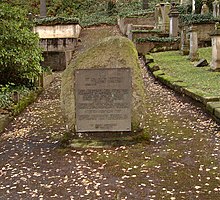Arnsberg Jewish cemetery
The Arnsberg Jewish cemetery was established in 1847. The last burial was probably in 2008. The site is a listed building.
history
No Jews were tolerated in Arnsberg until the end of the Duchy of Westphalia . This changed with the transition to Hessen-Darmstadt . The first Jewish families settled in the city around 1810. In the first decades the deceased of the young Jewish community were buried in the cemetery in Hüsten . When a deceased was to be buried in Hüsten in 1824, there was a dispute with the Hüsten Jewish community, who wanted to refuse this burial because the Arnsbergers no longer belonged to the Hüsten synagogue community. In order to avoid further such conflicts, the Arnsberg government instructed the district administrator and the city of Arnsberg to designate their own burial site. Originally, a plot of land in Eichholz was planned. For unknown reasons, this did not happen. In the following decades the dead continued to be buried in Hüsten.
It was not until 1847 that the cemetery was laid out on Alten Kuhweg on Seltersberg, at that time far outside the city. In the same year the first burial took place on the 15.07 ares large property. The first to die, whose tombstone is still preserved today, was Caroline Neuwahl (née Eichwald). Her tombstone bears a Hebrew inscription on the front and a German inscription on the back.
Initially, the cemetery was officially owned by a few Jewish citizens before it became the property of the synagogue community in 1886. In 1901 the municipality created a cemetery order. After that, not only the Jewish residents of Arnsberg, but also those from Oeventrop and Freienohl were buried there. Along with the synagogue, the cemetery was a central part of the community.
During the time of National Socialism it was desecrated, tombstones were knocked over or smashed. The last burial took place in 1938. The Jewish residents emigrated or were deported to the extermination camps . Officially, the Jewish community remained in possession of the property until 1943, after which it was transferred to the Reich Association of Jews in Germany . A previously agreed forced sale to the city of Arnsberg apparently had no consequences. During the war, the site was used to bury forced laborers, who were exhumed after the war and reburied in the forest cemetery.
After the liberation in 1945, the cemetery became the property of the Jewish Trust Corporation for Germany , based in London, and in 1959 the State Association of the Jewish Communities of Westphalia . As early as 1945, the Westphalian High Presidium in Münster had ordered the Jewish cemeteries to be repaired and former members of the SA to be consulted. The Arnsberg District President issued similar instructions.
In fact, the site in Arnsberg was restored. A memorial stone was unveiled during Fraternity Week 1973. Every year the citizens of the city commemorate the victims of the Holocaust in Arnsberg on the occasion of the Reichspogromnacht in 1938. The names and dates of life, the occupation and the destination of the deportation of the dead are read out.
literature
- Karl Föster : The Jewish cemetery. In: Michael Gosmann (Ed.): Jews in Arnsberg. A documentation (= urban history series of publications on the city of Arnsberg 18). City of Arnsberg, Arnsberg 1991, ISBN 3-928394-05-3 , pp. 87-92.
Web links
Coordinates: 51 ° 23 '37.5 " N , 8 ° 3' 7.4" E


